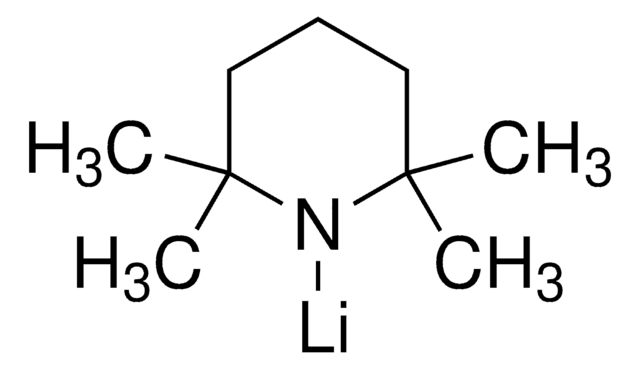All Photos(3)
About This Item
Linear Formula:
[(CH3)2CH]2NLi
CAS Number:
Molecular Weight:
107.12
Beilstein:
3655042
EC Number:
MDL number:
UNSPSC Code:
12352001
PubChem Substance ID:
NACRES:
NA.22
Recommended Products
vapor density
>1 (vs air)
Quality Level
Assay
97%
form
solid
density
0.864 g/mL at 25 °C (lit.)
functional group
amine
SMILES string
[Li]N(C(C)C)C(C)C
InChI
1S/C6H14N.Li/c1-5(2)7-6(3)4;/h5-6H,1-4H3;/q-1;+1
InChI key
ZCSHNCUQKCANBX-UHFFFAOYSA-N
Looking for similar products? Visit Product Comparison Guide
Related Categories
General description
Lithium diisopropylamide (LDA) is a hindered non-nucleophilic strong base that abstracts hydrogen from active carbon. It can be prepared from diisopropylamine and butyllithium in the presence of tetrahydrofuran.
Application
Lithium diisopropylamide can be used for the generation of carbanion or enolate anions from carbonyl group-containing compounds.
It can also be used as a base in:
It can also be used as a base in:
- The direct alkylation and acylation of ketones.
- The aldol condensation reaction.
- α-Selenation reaction.
- The synthesis of α, β- unsaturated carbonyl compounds from carbonyl compounds.
- The alkylation of acids, esters, amides, and nitriles.
- The initiation of anionic polymerization.
Signal Word
Danger
Hazard Statements
Precautionary Statements
Hazard Classifications
Eye Dam. 1 - Pyr. Sol. 1 - Skin Corr. 1B
Supplementary Hazards
Storage Class Code
4.2 - Pyrophoric and self-heating hazardous materials
WGK
WGK 2
Personal Protective Equipment
dust mask type N95 (US), Eyeshields, Gloves
Choose from one of the most recent versions:
Already Own This Product?
Find documentation for the products that you have recently purchased in the Document Library.
Customers Also Viewed
Journal of Polymer Science Part A: Polymer Chemistry, 32, 2425-2425 (1994)
Aldrichimica Acta, 17, 80-80 (1984)
Joshua D Schaefferkoetter et al.
Physics in medicine and biology, 60(14), 5543-5556 (2015-07-03)
In the context of investigating the potential of low-dose PET imaging for screening applications, we developed methods to assess small lesion detectability as a function of the number of counts in the scan. We present here our methods and preliminary
Juan Eugenio Iglesias et al.
NeuroImage, 115, 117-137 (2015-05-06)
Automated analysis of MRI data of the subregions of the hippocampus requires computational atlases built at a higher resolution than those that are typically used in current neuroimaging studies. Here we describe the construction of a statistical atlas of the
Erwei Yin et al.
IEEE transactions on neural systems and rehabilitation engineering : a publication of the IEEE Engineering in Medicine and Biology Society, 23(4), 693-701 (2015-02-24)
The present study proposes a hybrid brain-computer interface (BCI) with 64 selectable items based on the fusion of P300 and steady-state visually evoked potential (SSVEP) brain signals. With this approach, row/column (RC) P300 and two-step SSVEP paradigms were integrated to
Global Trade Item Number
| SKU | GTIN |
|---|---|
| 246611-25G | 4061825876870 |
| 246611-100G | 4061825876856 |
Our team of scientists has experience in all areas of research including Life Science, Material Science, Chemical Synthesis, Chromatography, Analytical and many others.
Contact Technical Service








